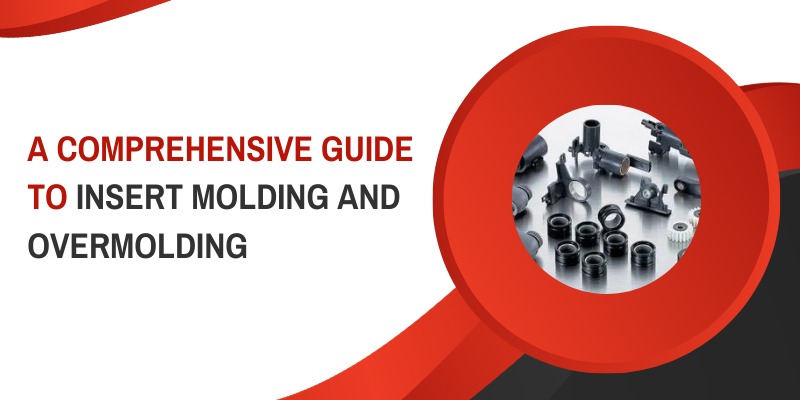“Simplify complex designs with cost-effective insert molding solutions.”
In the world of modern manufacturing, creating high-quality, multi-material products efficiently is crucial. Two key processes that enable this are insert molding and overmolding. These advanced techniques not only streamline production by reducing assembly steps but also enhance the durability and functionality of the final products. Whether you’re developing connectors, medical instruments, or consumer electronics, understanding the intricacies of insert molding and overmolding can significantly impact your production outcomes.
This comprehensive guide provides the detailed process of each, compares their benefits and drawbacks, and provides insights into choosing the best method for your next injection molding project with Neoplastics.
What is Insert Molding?
Insert molding is a manufacturing process where molten plastic like (HDPE, PP, ABS, Nylon) is injected around pre-placed inserts, typically made of metal. This process creates a strong bond between the plastic and the insert, reducing assembly operations and saving time. Common inserts include pins, blades, threaded nuts, knobs, sleeves, bushings, and the metal shanks of tools like screwdrivers.
What is Overmolding?
Overmolding allows manufacturers to produce parts from multiple materials using either a manual two-stage process for small production runs or an automated two-stage process for larger runs. Initially, a Hardplastic like (HDPE, PP, ABS, Nylon) is injected forms the rigid substrate and the second stage will be typically thinner and more flexible material (TPE, PVC & PU) is then injected around the substrate. As the materials cool, they bond together to create a unified, strong, and durable part. Bonds can be chemical or mechanical, depending on the materials and the design of the part.
Comparing Insert Molding to Overmolding
Both overmolding and insert molding allow manufacturers to create multi-material products without adhesives, eliminate secondary assembly steps, and improve the final product. However, there are key differences between the two:
Process
- Overmolding: Involves two material injections to form the substrate and the overmold.
- Insert Molding: Involves a single injection of molten plastic around a separately purchased or created metal insert.
Speed
- Insert Molding: Generally has a faster cycle time due to the single-shot process. However, creating custom metal inserts can extend production timelines.
- Overmolding: Takes longer due to the multiple injection steps.
Cost
- Insert Molding: More cost-effective as it involves a single injection step.
- Overmolding: More expensive due to the two-step process, especially for prototypes or small production runs requiring two tools.
Applications
- Overmolding: Commonly used for items like toothbrushes, medical instruments, disposable razors, phone cases, and electronic circuit boards (e.g., USB flash drives). Ideal for parts requiring different electrical or thermal properties, increased shock absorption or vibration damping, multi-colored plastics, comfortable non-stick grips, or embedded soft seals.
Eg: Handel for grips
- Insert Molding: Suitable for connectors, dash panels, electric sockets and wires, dials, remote control coverings, handles, scissor grips, and surgical implements. Ideal for parts with metal components, substrates including wires or circuit boards, avoiding the cost of a complex two-shot mold, or incorporating threaded inserts.
Eg: Brass inserts, ppe, hard material inside and smooth material.
When to Choose Overmolding or Insert Molding
Opt for Overmolding if:
- Your part’s surface needs diverse electrical or thermal properties.
- You want to improve shock absorption or vibration damping.
- You require a multi-colored plastic component.
- Your part needs a comfortable, non-stick grip.
- You need to integrate soft seals into your part.
Opt for Insert Molding if:
- Your part includes a metal component.
- Your substrate features wires, electronic parts, or circuit boards.
- You want to avoid the cost of a complex two-shot mold.
- You need to integrate threaded inserts into your part.
Interesting fact:
Overmolding enhances product durability by seamlessly bonding multiple materials, reducing the need for adhesives, and simplifying assembly processes, making it a top choice for creating ergonomic, multi-functional parts.
Injection Molding with Neoplastics
“Opt for multi-colored plastic parts with seamless overmolding- Neoplastics”
Insert molding and overmolding are both valuable multi-material injection molding processes, each with its own benefits and drawbacks. Choosing the right process depends on the specific requirements of your part. For expert advice on selecting the best technique, contact us at Neoplastics. Our team of experts is ready to help you turn your design into reality. With our suite of online tools, you can easily design and order parts, upload your part file, get DFM analysis, and explore production and material options. When you’re ready, obtaining a rapid quote is simple. Contact us today for the design and manufacturing insight you need to bring your next injection molding project to life.
FAQ’s:
What are the main differences between insert molding and overmolding?
Insert molding involves a single injection around a metal insert, while overmolding uses two injections to create a composite part. Overmolding often provides more design flexibility but can be more complex and costly.
When should I use insert molding?
Use insert molding if your product includes metal components, electronic parts, or requires threaded inserts. It’s ideal for applications needing robust bonding without the complexity of two-shot molding.
When is overmolding the best choice?
Overmolding is best for products needing enhanced shock absorption, multi-colored parts, or improved grip. It’s commonly used for making toothbrushes, phone cases, and medical instruments, where combining different materials can enhance functionality and comfort.
We update blogs regularly to help you. Be sure to check out the Neoplastic.in for more insights.
